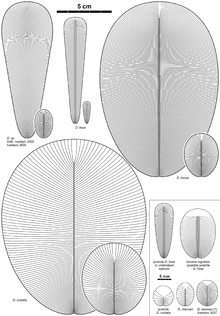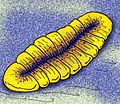
Dickinsonia is a genus of extinct organism, most likely an animal, that lived during the late Ediacaran period in what is now Australia, China, Russia and Ukraine. It is one of the best known members of the Ediacaran biota. The individual Dickinsonia typically resembles a bilaterally symmetrical ribbed oval. Its affinities are presently unknown; its mode of growth has been considered consistent with a stem-group bilaterian affinity, though various other affinities have been proposed. The discovery of cholesterol molecules in fossils of Dickinsonia lends support to the idea that Dickinsonia was an animal, though these results have been questioned.

Kimberella is an extinct genus of bilaterian known only from rocks of the Ediacaran period. The slug-like organism fed by scratching the microbial surface on which it dwelt in a manner similar to the gastropods, although its affinity with this group is contentious.
Segmentation in biology is the division of some animal and plant body plans into a linear series of repetitive segments that may or may not be interconnected to each other. This article focuses on the segmentation of animal body plans, specifically using the examples of the taxa Arthropoda, Chordata, and Annelida. These three groups form segments by using a "growth zone" to direct and define the segments. While all three have a generally segmented body plan and use a growth zone, they use different mechanisms for generating this patterning. Even within these groups, different organisms have different mechanisms for segmenting the body. Segmentation of the body plan is important for allowing free movement and development of certain body parts. It also allows for regeneration in specific individuals.
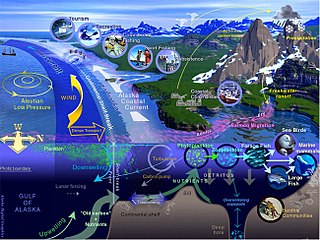
Marine life, sea life, or ocean life is the plants, animals, and other organisms that live in the salt water of seas or oceans, or the brackish water of coastal estuaries. At a fundamental level, marine life affects the nature of the planet. Marine organisms, mostly microorganisms, produce oxygen and sequester carbon. Marine life, in part, shape and protect shorelines, and some marine organisms even help create new land.
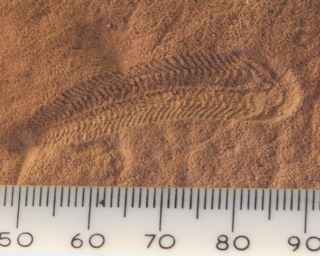
Spriggina is a genus of early bilaterian animals whose relationship to living animals is unclear. Fossils of Spriggina are known from the late Ediacaran period in what is now South Australia. Spriggina floundersi is the official fossil emblem of South Australia; it has been found nowhere else.

Vendobionts or Vendozoans (Vendobionta) are a proposed very high-level, extinct clade of benthic organisms that made up of the majority of the organisms that were part of the Ediacaran biota. It is a hypothetical group and at the same time, it would be the oldest of the animals that populated the Earth about 580 million years ago, in the Ediacaran period. They became extinct shortly after the so-called Cambrian explosion, with the introduction of fauna formed by more recognizable groups and more related to modern animals. It is very likely that the whole Ediacaran biota is not a monophyletic clade and not every genus placed in its subtaxa is an animal.
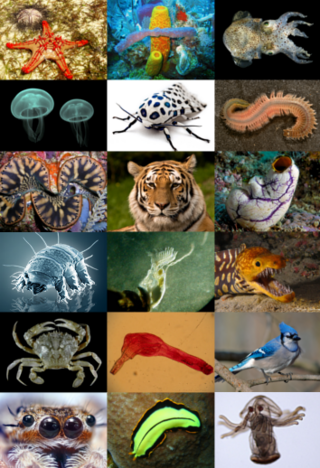
A body plan, Bauplan, or ground plan is a set of morphological features common to many members of a phylum of animals. The vertebrates share one body plan, while invertebrates have many.

Yorgia waggoneri is a discoid Ediacaran organism. It has a low, segmented body consisting of a short wide "head", no appendages, and a long body region, reaching a maximum length of 25 cm (9.8 in). It is classified within the extinct animal phylum Proarticulata.
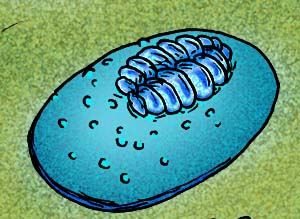
Cephalonega stepanovi is a fossil organism from Ediacaran deposits of the Arkhangelsk Region, Russia. It was described by Mikhail A. Fedonkin in 1976

Praecambridium sigillum is an extinct organism that superficially resembles a segmented trilobite-like arthropod. It was originally described as being a trilobite-like arthropod, though the majority of experts now place it within the Proarticulata as a close relative of the much larger Yorgia. It is from the Late Ediacaran deposit of Ediacara Hills, Australia, about 555 million years ago. On average, P. sigillum had at least 5 pairs of segments, with each unit becoming progressively larger as they approach the cephalon-like head.

The Ediacaranbiota is a taxonomic period classification that consists of all life forms that were present on Earth during the Ediacaran Period. These were enigmatic tubular and frond-shaped, mostly sessile, organisms. Trace fossils of these organisms have been found worldwide, and represent the earliest known complex multicellular organisms. The term "Ediacara biota" has received criticism from some scientists due to its alleged inconsistency, arbitrary exclusion of certain fossils, and inability to be precisely defined.

Proarticulata is a proposed phylum of extinct, bilaterally symmetrical animals known from fossils found in the Ediacaran (Vendian) marine deposits, and dates to approximately 567 to 550 million years ago. The name comes from the Greek προ = "before" and Articulata, i.e. prior to animals with true segmentation such as annelids and arthropods. This phylum was established by Mikhail A. Fedonkin in 1985 for such animals as Dickinsonia, Vendia, Cephalonega, Praecambridium and currently many other Proarticulata are described.

Marine invertebrates are the invertebrates that live in marine habitats. Invertebrate is a blanket term that includes all animals apart from the vertebrate members of the chordate phylum. Invertebrates lack a vertebral column, and some have evolved a shell or a hard exoskeleton. As on land and in the air, marine invertebrates have a large variety of body plans, and have been categorised into over 30 phyla. They make up most of the macroscopic life in the oceans.
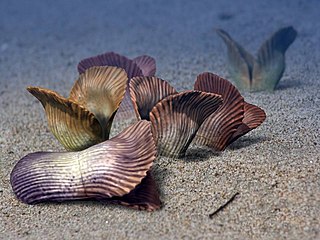
Ernietta is an extinct genus of Ediacaran organisms with an infaunal lifestyle. Fossil preservations and modeling indicate this organism was sessile and “sack”-shaped. It survived partly buried in substrate, with an upturned bell-shaped frill exposed above the sediment-water interface. Ernietta have been recovered from present-day Namibia, and are a part of the Ediacaran biota, a late Proterozoic radiation of multicellular organisms. They are among the earliest complex multicellular organisms and are known from the late Ediacaran. Ernietta plateauensis remains the sole species of the genus.

Windermeria aitkeni is a Precambrian organism from the Blueflower Formation of Sekwi Brook North, in the Northwest Territories of Canada. Only one specimen has been found. Windermeria is a small segmented elongated oval fossil with eight nearly equal-sized segments arranged transverse to medial furrow in opposite arrangement. Windermeria superficially resembles a diminutive Dickinsonia and as such is the only possible dickinsoniid proarticulatan known exclusively from outside of Australia and East Europe.

Isomer is an element of transverse body articulation of the bilateral fossil animals of the Phylum Proarticulata from the Ediacaran (Vendian) period. This term has been proposed by Andrey Yu. Ivantsov, a Russian paleontologist from the Laboratory of the Precambrian organisms, Paleontological Institute, Russian Academy of Sciences.

The annelids, also known as the segmented worms, are a large phylum, with over 22,000 extant species including ragworms, earthworms, and leeches. The species exist in and have adapted to various ecologies – some in marine environments as distinct as tidal zones and hydrothermal vents, others in fresh water, and yet others in moist terrestrial environments.

Until the late 1950s, the Precambrian was not believed to have hosted multicellular organisms. However, with radiometric dating techniques, it has been found that fossils initially found in the Ediacara Hills in Southern Australia date back to the late Precambrian. These fossils are body impressions of organisms shaped like disks, fronds and some with ribbon patterns that were most likely tentacles.
Palaeoplatoda is a genus from the Ediacaran biota. It is a soft-bodied organism with a segmented body that resembles Dickinsonia, another Ediacaran organism.
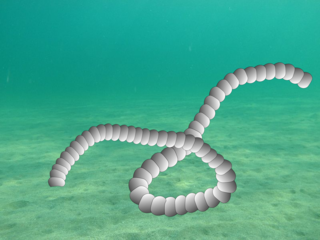
Plexus ricei is an enigmatic fossil animal known from South Australia, that has a problematic taxonomy due to its fossils not resembling any other known taxon that is part of the Ediacaran biota.
